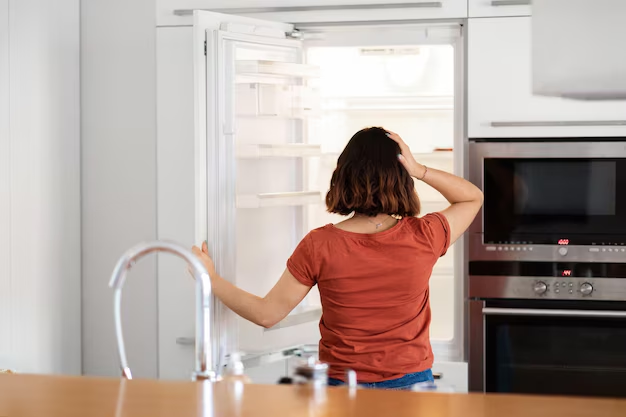Why Isn't My Refrigerator Cold? Troubleshooting Tips to Transform Your Cooling Woes
Has your refrigerator been underperforming lately? Finding that your fridge isn't getting cold can be alarming, especially when you've stocked up on groceries, only to discover that your food is at risk of spoiling. Let's delve into the reasons behind this common problem, highlighting potential causes and practical solutions to help restore your fridge to its optimal cooling capacity.
Common Reasons Your Refrigerator Won't Get Cold
🔧 Faulty Thermostat
The thermostat controls the temperature settings within your refrigerator. If it malfunctions or is incorrectly set, the cooling system may not kick in as required. Ensure the thermostat dial is set to the recommended temperature and consider testing it if performance issues persist.
🍃 Clogged Air Vents
Refrigerators rely on proper airflow between different compartments to maintain a consistent temperature. Check that air vents are not obstructed by food items, ice buildup, or debris, and clear any blockages to enhance airflow.
🌐 Issues with the Condenser Coils
Condenser coils release heat from the fridge. Dirty or blocked coils can cause the compressor to overheat, reducing cooling efficiency. Locate your refrigerator’s condenser coils, typically at the back or bottom, and clean them periodically.
❄️ Evaporator Fan Problems
The evaporator fan circulates cold air from the coils throughout the fridge. A malfunctioning fan can lead to inadequate cooling. Listen for unusual noises or inspect the fan for obstructions and replace it if necessary.
⚠️ Door Seal (Gasket) Failure
A faulty door gasket may allow cold air to escape, causing temperature fluctuations. Inspect your door seals for cracks or wear and consider replacing them if they’re worn out to prevent cool air from leaking.
🔋 Malfunctioning Compressor
The compressor is the heart of the refrigerator, responsible for cool air production. If it fails, the fridge won't cool at all. Though replacing a compressor may require professional assistance, check for unusual noises or a lack of humming when the fridge is running as initial indicators of trouble.
Key DIY Fixes for a Warmer-than-Desirable Fridge
Resetting the Thermostat
Steps to reset:
- Turn the thermostat dial to the coldest setting.
- Wait for 24 hours to see if the temperature stabilizes.
- If no improvement is noted, consider testing or replacing the thermostat.
Air Vent Check
- Important Tasks:
- Inspect for Obstructions: Move items away from the vents.
- Defrost Ice: If ice is present, manually defrost it before assessing airflow.
Cleaning Condenser Coils
- Supplies Needed: Vacuum cleaner with brush attachment or coil cleaning brush.
- Procedure:
- Unplug the refrigerator.
- Access the coils located at the rear/bottom.
- Use the brush/vacuum to remove dust and debris.
Checking the Evaporator Fan
- Inspection Process:
- Ensure the fan spins freely.
- Replace the fan if irregular sounds or resistance is noted.
Securing the Door Seal
- Maintenance Steps:
- Clean the Gasket with warm soapy water.
- Perform a Seal Test: Insert a piece of paper when the door is closed; if it slips out easily, the seal might need replacement.
Compressor Health Assessment
- Monitoring Signs:
- Listen for consistent humming when running.
- Consider Professional Assistance if replacement is necessary.
🤔 When to Call a Professional
While you can address many refrigerator issues with basic troubleshooting, some situations necessitate professional help, especially when handling electrical components or refrigerant gases. Seek expert assistance if:
- Electrical components like the compressor need replacing.
- You suspect a refrigerant leak.
- DIY fixes don't resolve the problem.
💼 Essential Tips for Optimal Fridge Maintenance
Regular maintenance can prevent many common issues. Here are some best practices to keep your refrigerator in top condition:
- Regularly clean condenser coils every six months.
- Defrost manually if frost buildup occurs frequently.
- Keep the fridge stocked appropriately: Avoid overloading, which can strain cooling capabilities, or leaving it understocked, which can affect temperature regulation.
- Close the door properly: Ensure no items are protruding, preventing a proper seal.
📋 Quick Troubleshooting Guide
| Problem | Potential Cause | Quick Fix |
|---|---|---|
| No cool air | Faulty thermostat/Compressor issue | Reset thermostat/Call a professional |
| Uneven cooling | Blocked vents/Evaporator fan | Clear vents/Inspect fan operation |
| Fridge warm, freezer cold | Damaged airflow between compartments | Check and clear all airways |
| Water pooling inside | Clogged defrost drain | Clean drain line/Unclog it |
| Increased power usage | Dirty condenser coils | Clean coils regularly |
👀 Final Insights: Guarding Your Groceries
By understanding the mechanics of how a refrigerator works and the common problems that can arise, you become more equipped to address issues head-on. Whether it’s performing simple maintenance, troubleshooting, or understanding when it’s time to bring in an expert, these insights help keep your refrigerator running smoothly. Remember, consistent upkeep and attention to early warning signs can extend the life of your appliance and save you from costly food spoilage. Stay proactive and ensure a chill environment for your household essentials!
